Seed Science and Technology - Seed Quality.pptx
Download as PPTX, PDF0 likes15 views
Seed Science and Technology - Seed Quality.pptx
1 of 42
Download to read offline
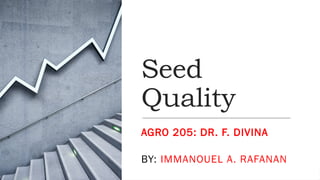

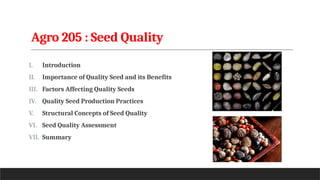
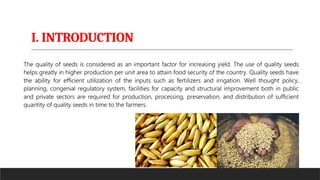
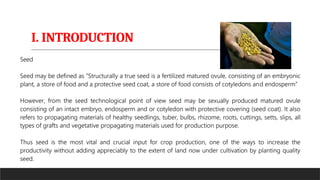

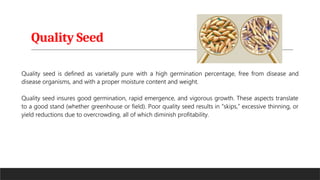
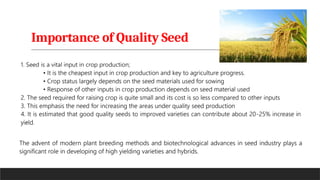

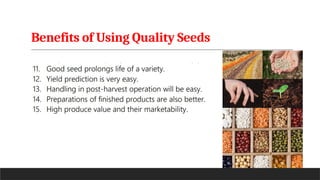

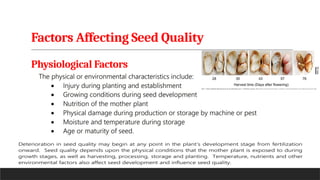
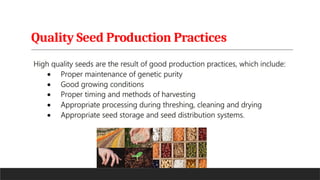
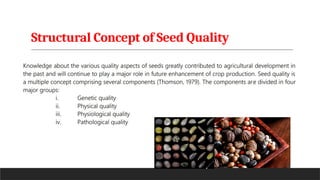

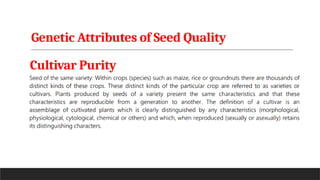

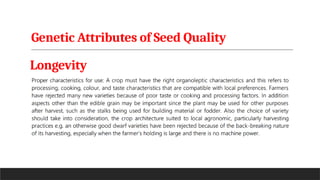
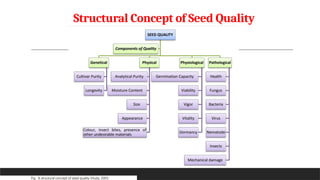
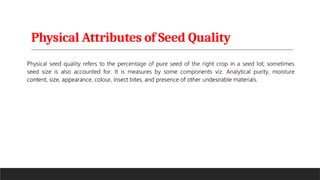
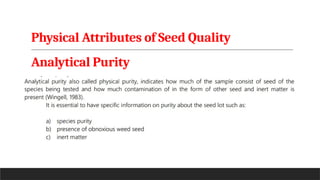


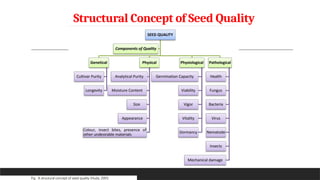
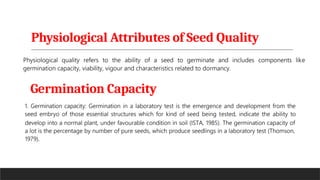
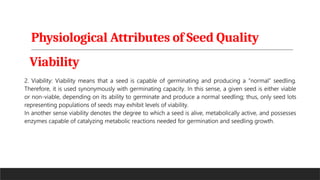
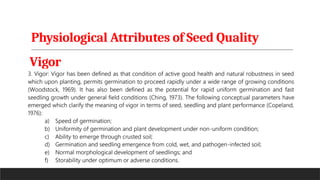
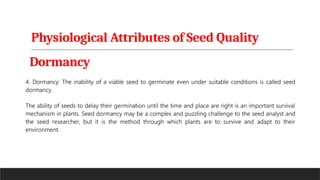
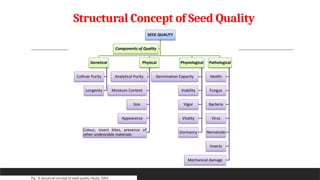
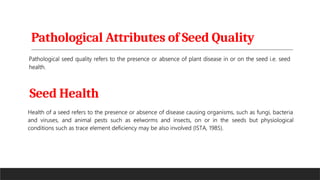
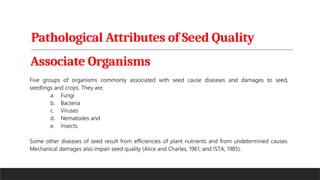

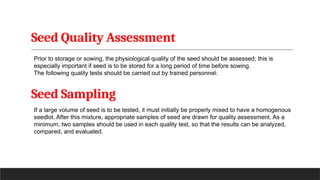
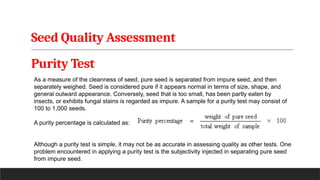

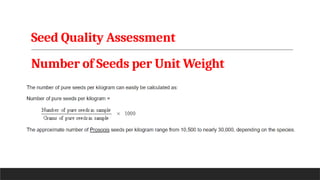

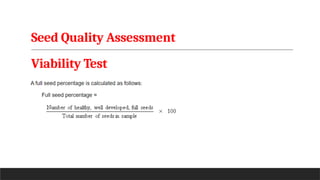

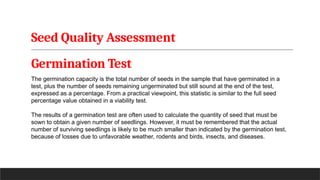
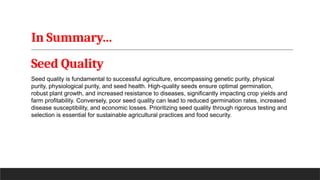

Ad
Recommended
A brief Study on Quality Control Attributes of Agricultural Inputs (seeds and...
A brief Study on Quality Control Attributes of Agricultural Inputs (seeds and...Md Kamaruzzaman
╠²
Bangladesh, an agriculture-based country, faces significant challenges in seed quality and fertilizer use, with 90% of seeds being farmer-sourced and many suffering from quality issues and diseases. This document discusses the importance of high-quality seeds and fertilizers for agricultural productivity, outlining standards for seed testing, quality control measures, and best practices for ensuring seed health. Additionally, it details methodologies for evaluating seed purity, germination, moisture content, and viability to enhance agricultural outputs.Concept of Seed Quality Testing.pdf
Concept of Seed Quality Testing.pdfKumari Rajani
╠²
The document discusses seed quality testing, emphasizing the importance of genetic and physical purity for ensuring high seed quality, which is crucial for achieving higher agricultural yields and food security. It outlines various attributes of seed quality, including germination percentage, moisture content, and seed vigor, as well as the historical development of seed testing methodologies and laboratories in India. The document also highlights the objectives of seed testing and the significance of proper sampling and laboratory standards in determining seed quality evaluations.Seed quality testing
Seed quality testing Shweta Tiwari
╠²
Seed quality testing involves evaluating various parameters of a seed lot such as physical, physiological, genetic and storability attributes. The key tests include moisture content, physical purity analysis, germination testing, seed viability assessment using tetrazolium testing, and disease testing. Seed sampling and handling procedures are important aspects of sample management in a seed testing laboratory. The primary aim of seed testing is to provide accurate results on the quality status of seed samples submitted. This allows farmers to obtain high quality seeds suited to local growing conditions.SEED TESTING AND SEED certification.pptx
SEED TESTING AND SEED certification.pptx28SubhrajyotiMohanty
╠²
The document covers nursery management for ornamental plants with a focus on seed types and certification processes. It explains the different classes of seeds including breeder, foundation, certified, and truthfully labeled seeds, along with their characteristics and production protocols. Additionally, it details the importance of seed testing and certification to ensure quality and genetic purity in agricultural practices.tranining.pptx
tranining.pptxTalilaGaramu
╠²
The document discusses guidelines for wheat seed production and quality control in Ethiopia, outlining key considerations for seed classes, field requirements including site selection, variety choice, land preparation, sowing methods, and seed rates. Quality components covered include genetic, physical, physiological, and health aspects. The goal is to provide improved seeds to farmers to boost agricultural productivity and food security.seed testing for quality assessment
seed testing for quality assessment DEEN DAYAL CHAUDHARY
╠²
The document provides an overview of seed testing for quality assessment, highlighting its importance for evaluating seed standards such as purity, moisture, germination, and viability. It outlines the objectives of seed testing, including identifying quality issues and ensuring compliance with established standards. Additionally, it details various quality assessment tests and the role of seed testing laboratories in supporting producers and consumers in the seed industry.Quality Seed Production in Agriculture
Quality Seed Production in AgricultureRamyajit Mondal
╠²
This document discusses the significance of quality seed production in agriculture, highlighting the essential role seeds play in plant development and crop yields. It outlines the characteristics of quality seeds, parameters for evaluation, and the seed production process, including various classifications and the importance of seed certification. Additionally, it provides insights into the global and Indian scenarios of seed production, and initiatives like the Seed Village Scheme aimed at improving seed quality through farmer participation.Role of-seed-in-vegetable-production
Role of-seed-in-vegetable-productionJunaid Abbas
╠²
Seed quality is the most important factor influencing vegetable crop yields. High quality seeds are genetically pure, physically pure, disease-free, have high germination rates, and proper moisture levels. Choosing adapted seed varieties, maintaining optimal plant populations and growing conditions, and using balanced fertilization and pest management practices can also help maximize yields. Seed labeling requirements aim to provide information on seed purity, germinability, and any health issues to help farmers select seeds suited to their needs.Seed type and characterstics
Seed type and charactersticsAnkush Singh
╠²
Seed are the propagators of plant species and ensure future crop growth. There are various types of seeds classified based on their quality and intended use. The highest quality seeds are Breeder or Nucleus seeds, which are directly controlled by plant breeders. Foundation, Registered and Certified seeds are progressively lower in quality but suitable for commercial crop production. Seed quality is determined by testing for characteristics like viability, purity, and freedom from pests. Proper production and storage help maintain high seed quality over time.TLE 10 - Horticulture Lesson 1 - Quarter 1
TLE 10 - Horticulture Lesson 1 - Quarter 1John Burca
╠²
This document outlines the importance of selecting high-quality seeds for agricultural success, particularly in rice cultivation, detailing characteristics of good seeds, such as high germination rates and genetic purity. It classifies seeds into four categories: breeder, foundation, registered, and certified, emphasizing that pure and disease-free seeds yield better crop results. Additionally, it highlights the necessity of seed viability testing to ensure effective germination before planting.Day 3 - Module 3: Seed Quality Control - Session 2
Day 3 - Module 3: Seed Quality Control - Session 2AfricaSeeds
╠²
This document provides information on seed quality control and certification procedures. It discusses the importance of seed testing, the roles of seed testing laboratories, and standard procedures for laboratory seed testing, including physical purity analysis, determination of other seeds, germination testing, and tetrazolium testing. The goal of seed testing is to predict seed performance, determine seed value, and minimize risks from low quality seeds. Laboratories help ensure seed quality but do not improve seeds themselves.SEED PROPAGATION.pptx
SEED PROPAGATION.pptxDr CHITHRA
╠²
Seed propagation, also known as sexual propagation, involves creating genetically diverse progeny through seeds produced by flowering plants. The process encompasses multiple stages including seed production, certification, quality analysis, and treatment to enhance germination, as well as essential conditions for successful germination such as light, water, and temperature. Moreover, proper practices in seed bed preparation, transplantation, and ongoing care are critical for successful plant propagation and improving horticultural yields.Seed science and technology - Basics
Seed science and technology - BasicsVIJAYKUMARSHRIVASTAV2
╠²
The document discusses seed science and technology, defining seeds as plant parts that carry living embryos capable of producing identical plants. It highlights the importance of quality seeds for agriculture, emphasizing factors such as genetic and physical purity, seed germination, and dormancy. Seed technology aims to improve seed production, maintenance, and quality, contributing to higher crop yields and innovative agricultural practices.Day 3 - Module 3: Seed Quality Control - Session 1
Day 3 - Module 3: Seed Quality Control - Session 1AfricaSeeds
╠²
The document outlines the concept of seed quality, emphasizing its importance in ensuring optimal crop yields and the adoption of new varieties by farmers. It details various parameters that define seed quality, such as genetic purity, physical condition, physiological performance, and health status. Additionally, it highlights the differences between formal and informal seed systems, factors affecting seed production, and the processes involved in seed sampling and testing to evaluate quality.Nutritional quality of seeds
Nutritional quality of seedsTanuja M
╠²
The document discusses the importance of seed quality and nutritional quality of seeds. It states that seed is the first determinant of future plant development and quality seed is a vital input for crop production [1]. It then provides details on seed quality parameters like physical, physiological, and genetic attributes as well as storability [2]. Finally, it outlines procedures for maintaining genetic purity in seed production like isolation distance and rouging [3].Seed testing and sampling
Seed testing and samplingAnshul Phaugat
╠²
Seed testing is essential for assessing seed viability and quality, governed by India's Seed Act of 1966. The process involves various tests and sampling methods to measure germination rates and identify any quality issues, ensuring seeds meet established standards before being distributed to farmers. Seed testing laboratories play a crucial role in quality control, with multiple testing techniques utilized to evaluate seed performance and health.Seed quality testing of vegetable seeds at lab
Seed quality testing of vegetable seeds at labganesh2775
╠²
The document discusses the significance of seed quality testing, highlighting various tests including purity, germination, viability, and vigor tests, which are essential for determining seed quality attributes. It provides an overview of the history of seed testing laboratories in Nepal, seed sampling methods, and the impact of quality seeds on agricultural productivity and storage. The conclusion emphasizes the importance of rigorous testing and quality control to enhance seed performance and farmer income.Methods of Seed-Quality testing in lab.pptx
Methods of Seed-Quality testing in lab.pptxganesh2775
╠²
The document outlines the importance of seed quality testing, which involves various methods to assess purity, germination, viability, vigor, and moisture content of seeds. It describes the history of seed testing in Nepal, the different types of tests conducted, and the importance of quality seeds in enhancing productivity and income for farmers. Key attributes and testing methods are highlighted, emphasizing that accurate sampling and testing are crucial for maintaining seed quality.Seed Testing for Grade 12 students. PPts
Seed Testing for Grade 12 students. PPtsAnalizaBowes
╠²
The document outlines seed testing methods essential for assessing seed quality and viability in agriculture. It discusses various tests, including germination, purity, vigor, disease, and physical tests, along with methods like the ragdoll method and petri dish method. Emphasizing the importance of seed testing, it aims to maximize crop yields by enabling informed seed selection and planting decisions.Seed, Seed Types and Seed Quality
Seed, Seed Types and Seed QualityTauqeer Yasir
╠²
Seed quality is determined by physical, physiological, genetic, and storability attributes. Physiological attributes include germination percentage and vigor. Genetic attributes ensure the seed is the correct variety and adapted to local conditions. Seed can be classified as breeder's, pre-basic, basic, or certified based on generation and quality controls. Germination occurs through epigeal or hypogeal modes and requires water, air, temperature, and sometimes light.Quality seed production
Quality seed productionsidjena70
╠²
Seed quality is determined by physical, physiological, genetic, and storability characteristics. Maintaining genetic purity during seed production requires controlling the seed source, isolation distances, rouging fields, certification, and grow-out tests. Key steps in quality seed production include selecting suitable regions and seed plots, proper land preparation, recommended varieties, treatments, planting methods, weed/pest control, irrigation, and timely harvesting and drying. This ensures high-quality seeds that perform well and retain desirable traits.Seed Quality and Characters of good quality Seeds.pptx
Seed Quality and Characters of good quality Seeds.pptxAKSHAYMAGAR17
╠²
1. Seed quality is determined by genetic and physical purity, physiological safety, and health status. Seeds of notified varieties are multiplied through a four-tier system involving ICAR institutes, state agricultural universities, seed corporations, and certification agencies.
2. Characters of good quality seeds include belonging to an improved variety with higher yields and disease resistance, genetic and physical purity, high germination rates and seed vigor, freedom from weeds and other crop seeds, good health without diseases or pests, appropriate moisture levels, large size and weight, and normal color and shine.
3. Key qualities are the seeds coming from improved varieties with 20-25% higher yields than existing varieties, having genetic and physical purityGeneral principles of seed production
General principles of seed production Junaid Abbas
╠²
The document discusses the importance of producing high quality pedigree seed through maintaining genetic purity and varietal characteristics. It states that seed production requires strict attention, high technical skills, and financial investment. Several factors can lead to the deterioration of seed varieties during production cycles, such as developmental variations due to different environmental conditions, mechanical mixtures during sowing and harvesting, natural crossing through pollination, and mutations. The document provides guidelines for maintaining varietal purity through practices like inspection of seed fields, rouging of off-type plants, adequate isolation distances, and periodic testing to ensure genetic purity is preserved in seed production.seed techonology.pptx
seed techonology.pptxBrajKishor22
╠²
This document discusses seed structure, quality, and technology. It defines a seed botanically and agronomically. The key parts of a seed's structure are described, including the testa, micropyle, hilum, cotyledon, radicle, plumule, and endosperm. Seed quality is said to refer to genetic and physical purity as well as physiological soundness and health. Maintaining seed quality ensures higher yields, farmer income, and crop performance. Seed technology involves research on seed development, production, processing, storage, testing, and supply to farmers in a timely manner.Characteristics of Good Quality Seeds.pptx
Characteristics of Good Quality Seeds.pptxJimLordLapastura
╠²
Seed quality is defined by purity, high germination rates, and proper moisture and weight. High quality seeds ensure good germination, growth, and yield. There are different classes of seeds - breeder, foundation, registered, and certified - which have increasing levels of genetic and physical purity as well as meeting certification standards. Using quality seeds provides many benefits including being true to type, higher yields, less weeds and pests, uniform growth, and crops that are more marketable. While seeds can be bought, producing one's own seeds ensures ready supply and improved quality but requires more expertise.Seed Testing for Germination
Seed Testing for GerminationVasantrao Nail Marathwada Krishi Vidyapeeth, Parbhani
╠²
This document provides information about seed germination testing procedures. It discusses:
- The importance of germination testing to determine seed viability and expected field performance. Standardized testing methods are used.
- How a germination test is conducted, including randomly selecting seeds, placing them in controlled conditions of moisture, temperature and substrate (usually sand or paper), and evaluating results after a set period.
- The categories used to classify germination results, including normal seedlings, abnormal seedlings, dormant seeds, dead seeds, and more.
- How germination test results are used by seed analysts and farmers to assess seed lot quality and guide planting and treatment decisions.New Microsoft Office PowerPoint Presentation.pptx
New Microsoft Office PowerPoint Presentation.pptxAshuSingh402401
╠²
Viability indicates a seed's potential to germinate under suitable conditions, while germination is the actual process of sprouting. Factors such as seed coat, age, type, genetics, and diseases affect both viability and germination rates. Experiments show that most seeds tested germinate successfully, but cucumis melo has significantly lower germination rates, possibly due to age or dormancy.Developing an Integrated TIMES-CGE-PLEXOS Framework for Assessing TaiwanŌĆÖs En...
Developing an Integrated TIMES-CGE-PLEXOS Framework for Assessing TaiwanŌĆÖs En...IEA-ETSAP
╠²
Developing an Integrated TIMES-CGE-PLEXOS Framework for Assessing TaiwanŌĆÖs Energy Policies
Ms. YUNG CHI YEH, Industrial Technology Research Institute, TaiwanRole of Carbon Pricing and Emissions Constraint Pathways for IndiaŌĆÖs Net-Zero...
Role of Carbon Pricing and Emissions Constraint Pathways for IndiaŌĆÖs Net-Zero...IEA-ETSAP
╠²
Role of Carbon Pricing and Emissions Constraint Pathways for IndiaŌĆÖs Net-Zero Transition: A Cross-Sectoral TIMES Model Analysis
ANU AGARWAL, Indian Institute of Technology, Roorkee, IndiaMore Related Content
Similar to Seed Science and Technology - Seed Quality.pptx (20)
Seed type and characterstics
Seed type and charactersticsAnkush Singh
╠²
Seed are the propagators of plant species and ensure future crop growth. There are various types of seeds classified based on their quality and intended use. The highest quality seeds are Breeder or Nucleus seeds, which are directly controlled by plant breeders. Foundation, Registered and Certified seeds are progressively lower in quality but suitable for commercial crop production. Seed quality is determined by testing for characteristics like viability, purity, and freedom from pests. Proper production and storage help maintain high seed quality over time.TLE 10 - Horticulture Lesson 1 - Quarter 1
TLE 10 - Horticulture Lesson 1 - Quarter 1John Burca
╠²
This document outlines the importance of selecting high-quality seeds for agricultural success, particularly in rice cultivation, detailing characteristics of good seeds, such as high germination rates and genetic purity. It classifies seeds into four categories: breeder, foundation, registered, and certified, emphasizing that pure and disease-free seeds yield better crop results. Additionally, it highlights the necessity of seed viability testing to ensure effective germination before planting.Day 3 - Module 3: Seed Quality Control - Session 2
Day 3 - Module 3: Seed Quality Control - Session 2AfricaSeeds
╠²
This document provides information on seed quality control and certification procedures. It discusses the importance of seed testing, the roles of seed testing laboratories, and standard procedures for laboratory seed testing, including physical purity analysis, determination of other seeds, germination testing, and tetrazolium testing. The goal of seed testing is to predict seed performance, determine seed value, and minimize risks from low quality seeds. Laboratories help ensure seed quality but do not improve seeds themselves.SEED PROPAGATION.pptx
SEED PROPAGATION.pptxDr CHITHRA
╠²
Seed propagation, also known as sexual propagation, involves creating genetically diverse progeny through seeds produced by flowering plants. The process encompasses multiple stages including seed production, certification, quality analysis, and treatment to enhance germination, as well as essential conditions for successful germination such as light, water, and temperature. Moreover, proper practices in seed bed preparation, transplantation, and ongoing care are critical for successful plant propagation and improving horticultural yields.Seed science and technology - Basics
Seed science and technology - BasicsVIJAYKUMARSHRIVASTAV2
╠²
The document discusses seed science and technology, defining seeds as plant parts that carry living embryos capable of producing identical plants. It highlights the importance of quality seeds for agriculture, emphasizing factors such as genetic and physical purity, seed germination, and dormancy. Seed technology aims to improve seed production, maintenance, and quality, contributing to higher crop yields and innovative agricultural practices.Day 3 - Module 3: Seed Quality Control - Session 1
Day 3 - Module 3: Seed Quality Control - Session 1AfricaSeeds
╠²
The document outlines the concept of seed quality, emphasizing its importance in ensuring optimal crop yields and the adoption of new varieties by farmers. It details various parameters that define seed quality, such as genetic purity, physical condition, physiological performance, and health status. Additionally, it highlights the differences between formal and informal seed systems, factors affecting seed production, and the processes involved in seed sampling and testing to evaluate quality.Nutritional quality of seeds
Nutritional quality of seedsTanuja M
╠²
The document discusses the importance of seed quality and nutritional quality of seeds. It states that seed is the first determinant of future plant development and quality seed is a vital input for crop production [1]. It then provides details on seed quality parameters like physical, physiological, and genetic attributes as well as storability [2]. Finally, it outlines procedures for maintaining genetic purity in seed production like isolation distance and rouging [3].Seed testing and sampling
Seed testing and samplingAnshul Phaugat
╠²
Seed testing is essential for assessing seed viability and quality, governed by India's Seed Act of 1966. The process involves various tests and sampling methods to measure germination rates and identify any quality issues, ensuring seeds meet established standards before being distributed to farmers. Seed testing laboratories play a crucial role in quality control, with multiple testing techniques utilized to evaluate seed performance and health.Seed quality testing of vegetable seeds at lab
Seed quality testing of vegetable seeds at labganesh2775
╠²
The document discusses the significance of seed quality testing, highlighting various tests including purity, germination, viability, and vigor tests, which are essential for determining seed quality attributes. It provides an overview of the history of seed testing laboratories in Nepal, seed sampling methods, and the impact of quality seeds on agricultural productivity and storage. The conclusion emphasizes the importance of rigorous testing and quality control to enhance seed performance and farmer income.Methods of Seed-Quality testing in lab.pptx
Methods of Seed-Quality testing in lab.pptxganesh2775
╠²
The document outlines the importance of seed quality testing, which involves various methods to assess purity, germination, viability, vigor, and moisture content of seeds. It describes the history of seed testing in Nepal, the different types of tests conducted, and the importance of quality seeds in enhancing productivity and income for farmers. Key attributes and testing methods are highlighted, emphasizing that accurate sampling and testing are crucial for maintaining seed quality.Seed Testing for Grade 12 students. PPts
Seed Testing for Grade 12 students. PPtsAnalizaBowes
╠²
The document outlines seed testing methods essential for assessing seed quality and viability in agriculture. It discusses various tests, including germination, purity, vigor, disease, and physical tests, along with methods like the ragdoll method and petri dish method. Emphasizing the importance of seed testing, it aims to maximize crop yields by enabling informed seed selection and planting decisions.Seed, Seed Types and Seed Quality
Seed, Seed Types and Seed QualityTauqeer Yasir
╠²
Seed quality is determined by physical, physiological, genetic, and storability attributes. Physiological attributes include germination percentage and vigor. Genetic attributes ensure the seed is the correct variety and adapted to local conditions. Seed can be classified as breeder's, pre-basic, basic, or certified based on generation and quality controls. Germination occurs through epigeal or hypogeal modes and requires water, air, temperature, and sometimes light.Quality seed production
Quality seed productionsidjena70
╠²
Seed quality is determined by physical, physiological, genetic, and storability characteristics. Maintaining genetic purity during seed production requires controlling the seed source, isolation distances, rouging fields, certification, and grow-out tests. Key steps in quality seed production include selecting suitable regions and seed plots, proper land preparation, recommended varieties, treatments, planting methods, weed/pest control, irrigation, and timely harvesting and drying. This ensures high-quality seeds that perform well and retain desirable traits.Seed Quality and Characters of good quality Seeds.pptx
Seed Quality and Characters of good quality Seeds.pptxAKSHAYMAGAR17
╠²
1. Seed quality is determined by genetic and physical purity, physiological safety, and health status. Seeds of notified varieties are multiplied through a four-tier system involving ICAR institutes, state agricultural universities, seed corporations, and certification agencies.
2. Characters of good quality seeds include belonging to an improved variety with higher yields and disease resistance, genetic and physical purity, high germination rates and seed vigor, freedom from weeds and other crop seeds, good health without diseases or pests, appropriate moisture levels, large size and weight, and normal color and shine.
3. Key qualities are the seeds coming from improved varieties with 20-25% higher yields than existing varieties, having genetic and physical purityGeneral principles of seed production
General principles of seed production Junaid Abbas
╠²
The document discusses the importance of producing high quality pedigree seed through maintaining genetic purity and varietal characteristics. It states that seed production requires strict attention, high technical skills, and financial investment. Several factors can lead to the deterioration of seed varieties during production cycles, such as developmental variations due to different environmental conditions, mechanical mixtures during sowing and harvesting, natural crossing through pollination, and mutations. The document provides guidelines for maintaining varietal purity through practices like inspection of seed fields, rouging of off-type plants, adequate isolation distances, and periodic testing to ensure genetic purity is preserved in seed production.seed techonology.pptx
seed techonology.pptxBrajKishor22
╠²
This document discusses seed structure, quality, and technology. It defines a seed botanically and agronomically. The key parts of a seed's structure are described, including the testa, micropyle, hilum, cotyledon, radicle, plumule, and endosperm. Seed quality is said to refer to genetic and physical purity as well as physiological soundness and health. Maintaining seed quality ensures higher yields, farmer income, and crop performance. Seed technology involves research on seed development, production, processing, storage, testing, and supply to farmers in a timely manner.Characteristics of Good Quality Seeds.pptx
Characteristics of Good Quality Seeds.pptxJimLordLapastura
╠²
Seed quality is defined by purity, high germination rates, and proper moisture and weight. High quality seeds ensure good germination, growth, and yield. There are different classes of seeds - breeder, foundation, registered, and certified - which have increasing levels of genetic and physical purity as well as meeting certification standards. Using quality seeds provides many benefits including being true to type, higher yields, less weeds and pests, uniform growth, and crops that are more marketable. While seeds can be bought, producing one's own seeds ensures ready supply and improved quality but requires more expertise.Seed Testing for Germination
Seed Testing for GerminationVasantrao Nail Marathwada Krishi Vidyapeeth, Parbhani
╠²
This document provides information about seed germination testing procedures. It discusses:
- The importance of germination testing to determine seed viability and expected field performance. Standardized testing methods are used.
- How a germination test is conducted, including randomly selecting seeds, placing them in controlled conditions of moisture, temperature and substrate (usually sand or paper), and evaluating results after a set period.
- The categories used to classify germination results, including normal seedlings, abnormal seedlings, dormant seeds, dead seeds, and more.
- How germination test results are used by seed analysts and farmers to assess seed lot quality and guide planting and treatment decisions.New Microsoft Office PowerPoint Presentation.pptx
New Microsoft Office PowerPoint Presentation.pptxAshuSingh402401
╠²
Viability indicates a seed's potential to germinate under suitable conditions, while germination is the actual process of sprouting. Factors such as seed coat, age, type, genetics, and diseases affect both viability and germination rates. Experiments show that most seeds tested germinate successfully, but cucumis melo has significantly lower germination rates, possibly due to age or dormancy.Recently uploaded (20)
Developing an Integrated TIMES-CGE-PLEXOS Framework for Assessing TaiwanŌĆÖs En...
Developing an Integrated TIMES-CGE-PLEXOS Framework for Assessing TaiwanŌĆÖs En...IEA-ETSAP
╠²
Developing an Integrated TIMES-CGE-PLEXOS Framework for Assessing TaiwanŌĆÖs Energy Policies
Ms. YUNG CHI YEH, Industrial Technology Research Institute, TaiwanRole of Carbon Pricing and Emissions Constraint Pathways for IndiaŌĆÖs Net-Zero...
Role of Carbon Pricing and Emissions Constraint Pathways for IndiaŌĆÖs Net-Zero...IEA-ETSAP
╠²
Role of Carbon Pricing and Emissions Constraint Pathways for IndiaŌĆÖs Net-Zero Transition: A Cross-Sectoral TIMES Model Analysis
ANU AGARWAL, Indian Institute of Technology, Roorkee, Indiaxl2times: progress update & a proof-of-concept interactive notebook-based wor...
xl2times: progress update & a proof-of-concept interactive notebook-based wor...IEA-ETSAP
╠²
xl2times: progress update & a proof-of-concept interactive notebook-based workflow
Mr. Siddharth Krishna, Open Energy TransitionWelcome to ETSAP Summer Workshop 2025, Prof. Brian ├ō Gallach├│ir
Welcome to ETSAP Summer Workshop 2025, Prof. Brian ├ō Gallach├│irIEA-ETSAP
╠²
Welcome to ETSAP Summer Workshop 2025
Prof. Brian ├ō Gallach├│ir
Chair IEA ETSAP Technology Collaboration Programme
Research Institute of Innovative Technology for the Earth, japanTIMES2JuMP project status report; Learnings on the feasibility of Migrating T...
TIMES2JuMP project status report; Learnings on the feasibility of Migrating T...IEA-ETSAP
╠²
TIMES2JuMP project status report; Learnings on the feasibility of Migrating TIMES to Julia JuMP
Dr. James Glynn, ESMA, IrelandThe plant-level decarbonization pathways and mitigation cost of global oil re...
The plant-level decarbonization pathways and mitigation cost of global oil re...IEA-ETSAP
╠²
The plant-level decarbonization pathways and mitigation cost of global oil refineries
Prof. Jing Meng, University College London, UKBiogas Power Plant with Glass-Fused-to-Steel Tank and Double Membrane Roof.docx
Biogas Power Plant with Glass-Fused-to-Steel Tank and Double Membrane Roof.docxAllenLin596164
╠²
Biogas Power Plant with Glass-Fused-to-Steel Tank and Double Membrane Roof.docxGreen Talks LIVE | Adapting to a drier world in a changing climate: Launch of...
Green Talks LIVE | Adapting to a drier world in a changing climate: Launch of...OECD Environment
╠²
Fuelled by climate change, extreme droughts are becoming more frequent, placing mounting pressure on communities, ecosystems and economies. As impacts intensify across regions and sectors, including in OECD countries, the urgency to build stronger drought resilience has never been greater. How is climate change intensifying the risks and impacts of droughts? What do recent drought episodes reveal about the socio-economic and environmental costs of inaction? And how can countries strengthen their climate adaptation strategies to reduce vulnerability, build resilience and mitigate long-term impacts?
Join us on 17 June 2025 for the launch of the new OECD report Global Drought Outlook: Trends, Impacts and Policies to Adapt to a Drier World. The report offers a global assessment of drought trends, drivers and impacts in the context of climate change, and examines how selected policies and practices across sectors can enhance drought resilience. Drawing from both successful adaptation efforts and persistent policy gaps, it provides actionable insights to guide decision-makers and support the efficient use of resources to address this escalating challenge.
The webinar will feature a panel of senior policymakers and provide a platform to discuss the OECDŌĆÖs latest findings and recommendations, as well as to exchange knowledge on drought resilience, policy innovations and opportunities in land and water management to adapt to a drier future.Implications of Party Politics for Future Energy System Scenarios in Norway
Implications of Party Politics for Future Energy System Scenarios in NorwayIEA-ETSAP
╠²
Implications of Party Politics for Future Energy System Scenarios in Norway
Dr. Pernille Seljom, Institute for Energy Technology (IFE), NorwayInternational Forestry Students Association: A World That Appreciates Forests
International Forestry Students Association: A World That Appreciates ForestsGlobal Landscapes Forum (GLF)
╠²
This presentation is one of the highlights of the Landscape Leadership Camp, held in Bogor, Indonesia, from 21ŌĆō23 April 2025. The camp brought together over 50 young landscape leaders committed to driving impactful and transformative change across the landscapes of Asia and the Pacific. Participants engaged in a series of activities, workshops, dialogues, and field trips ŌĆö all focused on reimagining the future of Asian landscapes through intergenerational knowledge and grounded action.Unmatched Color Palette for Every Season
Unmatched Color Palette for Every Seasonstarkhenna17
╠²
Looking for year-round interest? The dwarf Japanese maple offers unmatched seasonal appeal. In spring, their new leaves emerge like bursts of flame or gentle lace. Summer tones shift to deeper reds or greens, and by autumn, they explode with rich golds, oranges, and crimsons. Even in winter, their branch structure adds sculptural intrigue. Their ability to adapt to seasonal shifts makes them a designerŌĆÖs dream. YouŌĆÖll find the widest spectrum of color and form by browsing the curated collection at Conifer Kingdom, where quality and uniqueness are always guaranteed.
Visit: https://www.coniferkingdom.com/dwarf-maple/Future Low-Carbon Hydrogen Production Technology Penetration with Aspen-Based...
Future Low-Carbon Hydrogen Production Technology Penetration with Aspen-Based...IEA-ETSAP
╠²
Future Low-Carbon Hydrogen Production Technology Penetration with Aspen-Based Electrolyzer Modeling and GCAM
Mr. Ankur Singhal, Indian Institute of Technology Roorkee, IndiaRole of Nitrogen-Fixing Trees/Shrubs in Agroforestry
Role of Nitrogen-Fixing Trees/Shrubs in Agroforestryhinamandle07
╠²
Role of Nitrogen-Fixing Trees/Shrubs in AgroforestryCALCULATION TOOLS FOR ESTIMATING GREENHOUSE GAS EMISSIONS FROM PULP AND PAPER...
CALCULATION TOOLS FOR ESTIMATING GREENHOUSE GAS EMISSIONS FROM PULP AND PAPER...tuannguyenvan123
╠²
This report contains Version 1.1 of the Calculation Tools for Estimating Greenhouse Gas
Emissions from Pulp and Paper Mills, developed for the International Council of Forests and
Paper Associations by the National Council for Air and Stream Improvement, Inc. (NCASI).
The differences between this version of the tools and Version 1.0, issued in 2001, are
described in Annex G to this report. It is intended that these industry-specific tools be used
in conjunction with a greenhouse gas (GHG) accounting protocol such as the ŌĆ£Greenhouse
Gas ProtocolŌĆØ issued by the World Resources Institute/World Business Council for
Sustainable Development (WRI/WBCSD), the ŌĆ£Climate Leaders Greenhouse Gas Inventory
Protocol Core Module GuidanceŌĆØ issued by the United States Environmental Protection
Agency (USEPA), the ŌĆ£Challenge Registry Guide to Entity and Facility-Based ReportingŌĆØ
issued by the Voluntary Challenge and Registry (VCR), or other protocol for corporate GHGinventories.GLFx Himachal ŌĆō Ecologically Restoring Landscapes, Species, and Livelihoods
GLFx Himachal ŌĆō Ecologically Restoring Landscapes, Species, and LivelihoodsGlobal Landscapes Forum (GLF)
╠²
This presentation is one of the highlights of the Landscape Leadership Camp, held in Bogor, Indonesia, from 21ŌĆō23 April 2025. The camp brought together over 50 young landscape leaders committed to driving impactful and transformative change across the landscapes of Asia and the Pacific. Participants engaged in a series of activities, workshops, dialogues, and field trips ŌĆö all focused on reimagining the future of Asian landscapes through intergenerational knowledge and grounded action.Dry Bulk Storage Tanks Advanced Solutions for Bulk Material Storage.docx
Dry Bulk Storage Tanks Advanced Solutions for Bulk Material Storage.docxAllenLin596164
╠²
Dry Bulk Storage Tanks Advanced Solutions for Bulk Material Storage.docxAre Heavy-Duty Vehicles at a Crossroads? A Real Options and Innovation Diffus...
Are Heavy-Duty Vehicles at a Crossroads? A Real Options and Innovation Diffus...IEA-ETSAP
╠²
Are Heavy-Duty Vehicles at a Crossroads? A Real Options and Innovation Diffusion Perspective on Hydrogen Fuel Cell vs. Battery Electric trucks
Ms. OANA IONESCU RIFFAUD GAEL, Grenoble Institute of Technology, Universit├® Grenoble Alpes, FranceInternational Forestry Students Association: A World That Appreciates Forests
International Forestry Students Association: A World That Appreciates ForestsGlobal Landscapes Forum (GLF)
╠²
GLFx Himachal ŌĆō Ecologically Restoring Landscapes, Species, and Livelihoods
GLFx Himachal ŌĆō Ecologically Restoring Landscapes, Species, and LivelihoodsGlobal Landscapes Forum (GLF)
╠²
Ad
Seed Science and Technology - Seed Quality.pptx
- 1. Seed Quality AGRO 205: DR. F. DIVINA BY: IMMANOUEL A. RAFANAN
- 2. ŌĆ£DonŌĆÖt judge each day by the harvest you reap, but by the seeds that you plant. - ROBERT LOUIS STEVENSON Scottish novelist, essayist, poet and travel writer.
- 3. Agro 205 : Seed Quality I. Introduction II. Importance of Quality Seed and its Benefits III. Factors Affecting Quality Seeds IV. Quality Seed Production Practices V. Structural Concepts of Seed Quality VI. Seed Quality Assessment VII. Summary
- 7. Quality Seed
- 8. Importance of Quality Seed
- 9. Benefits of Using Quality Seeds
- 10. Benefits of Using Quality Seeds
- 11. Factors Affecting Seed Quality Genetic Factors
- 12. Factors Affecting Seed Quality Physiological Factors
- 13. Quality Seed Production Practices
- 14. Structural Concept of Seed Quality
- 15. Structural Concept of Seed Quality
- 16. Genetic Attributes of Seed Quality Cultivar Purity
- 17. Genetic Attributes of Seed Quality Cultivar Purity
- 18. Genetic Attributes of Seed Quality Longevity
- 19. Structural Concept of Seed Quality
- 20. Physical Attributes of Seed Quality
- 21. Physical Attributes of Seed Quality Analytical Purity
- 22. Physical Attributes of Seed Quality Moisture Content
- 23. Physical Attributes of Seed Quality Seed Size
- 24. Structural Concept of Seed Quality
- 25. Physiological Attributes of Seed Quality Germination Capacity
- 26. Physiological Attributes of Seed Quality Viability
- 27. Physiological Attributes of Seed Quality Vigor
- 28. Physiological Attributes of Seed Quality Dormancy
- 29. Structural Concept of Seed Quality
- 30. Pathological Attributes of Seed Quality Seed Health
- 31. Pathological Attributes of Seed Quality Associate Organisms
- 32. Pathological Attributes of Seed Quality Mechanical Damage
- 33. Seed Quality Assessment Prior to storage or sowing, the physiological quality of the seed should be assessed; this is especially important if seed is to be stored for a long period of time before sowing. The following quality tests should be carried out by trained personnel: Seed Sampling If a large volume of seed is to be tested, it must initially be properly mixed to have a homogenous seedlot. After this mixture, appropriate samples of seed are drawn for quality assessment. As a minimum, two samples should be used in each quality test, so that the results can be analyzed, compared, and evaluated.
- 34. Seed Quality Assessment Purity Test As a measure of the cleanness of seed, pure seed is separated from impure seed, and then separately weighed. Seed is considered pure if it appears normal in terms of size, shape, and general outward appearance. Conversely, seed that is too small, has been partly eaten by insects, or exhibits fungal stains is regarded as impure. A sample for a purity test may consist of 100 to 1,000 seeds. A purity percentage is calculated as: Although a purity test is simple, it may not be as accurate in assessing quality as other tests. One problem encountered in applying a purity test is the subjectivity injected in separating pure seed from impure seed.
- 35. Seed Quality Assessment Number of Seeds per Unit Weight It is important to know the number of seeds per unit weight in a seed collection to be stored, because this number and the germinative energy percentage, to be discussed below, can be used to calculate the approximate weight of seed required to produce a desired number of seedlings. To determine the number of seeds per unit weight, two or more random samples of, for example, 100 grams are taken from the seedlot. The number and weight of pure, full seeds are then obtained. As in the purity test, impure seed is rejected and all other retained.
- 36. Seed Quality Assessment Number of Seeds per Unit Weight
- 37. Seed Quality Assessment Viability Test It is important to know the number of seeds per unit weight in a seed collection to be stored, because this number and the germinative energy percentage, to be discussed below, can be used to calculate the approximate weight of seed required to produce a desired number of seedlings. To determine the number of seeds per unit weight, two or more random samples of, for example, 100 grams are taken from the seedlot. The number and weight of pure, full seeds are then obtained. As in the purity test, impure seed is rejected and all other retained.
- 38. Seed Quality Assessment Viability Test
- 39. Seed Quality Assessment Germination Test Often, full seeds that appear sound will not germinate because they were not fertilized or are too old. Therefore, the most reliable way to assess the quality of a seed collection is to actually germinate a sample of seeds from the collection. To determine the germination percentage, random samples of seed are tested by subjecting them to favorable germination conditions. A germination test can be made in containers, i.e., pots or tins used in nurseries, or in a simple, covered Petri dish. A variety of germination media are acceptable for a germination test, although the one used must furnish proper aeration and sufficient, but not excessive, moisture for each seed. Furthermore, it is important that the medium be sterile to prevent damage by fungi.
- 40. Seed Quality Assessment Germination Test The germination capacity is the total number of seeds in the sample that have germinated in a test, plus the number of seeds remaining ungerminated but still sound at the end of the test, expressed as a percentage. From a practical viewpoint, this statistic is similar to the full seed percentage value obtained in a viability test. The results of a germination test are often used to calculate the quantity of seed that must be sown to obtain a given number of seedlings. However, it must be remembered that the actual number of surviving seedlings is likely to be much smaller than indicated by the germination test, because of losses due to unfavorable weather, rodents and birds, insects, and diseases.
- 41. In SummaryŌĆ” Seed Quality Seed quality is fundamental to successful agriculture, encompassing genetic purity, physical purity, physiological purity, and seed health. High-quality seeds ensure optimal germination, robust plant growth, and increased resistance to diseases, significantly impacting crop yields and farm profitability. Conversely, poor seed quality can lead to reduced germination rates, increased disease susceptibility, and economic losses. Prioritizing seed quality through rigorous testing and selection is essential for sustainable agricultural practices and food security.
- 42. FOR LISTENING!